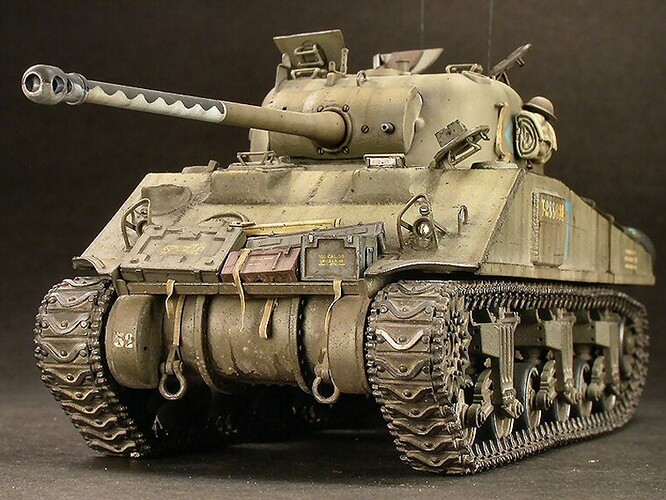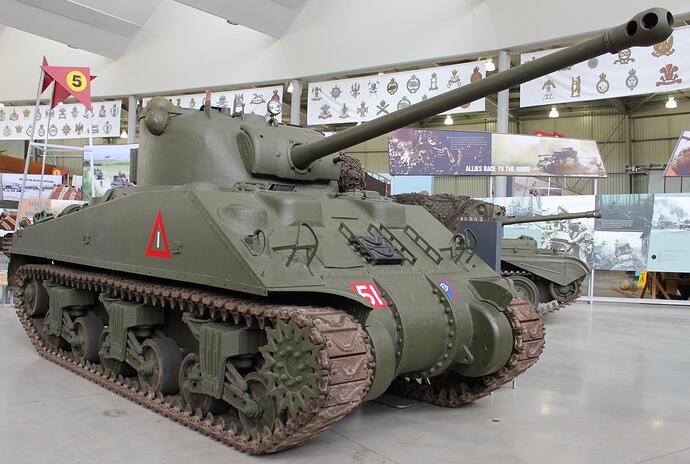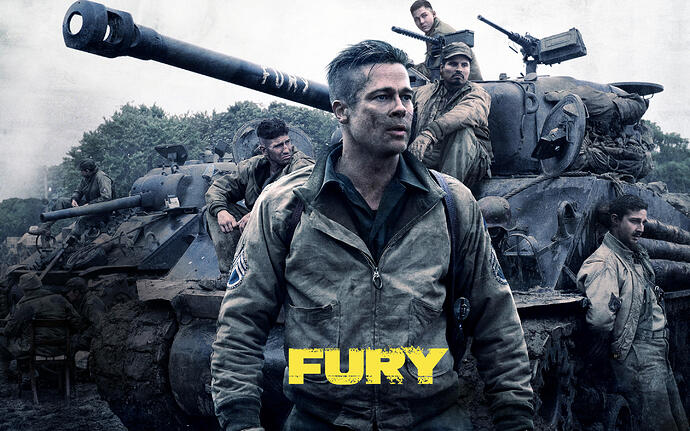The Sherman Firefly was a tank used by the British military that was adapted from the U.S. M4 Sherman tank. Instead of the original 75mm main gun, the Firefly was reconfigured to use the more powerful 76.2mm (3in.), 17 pounder British anti-tank round. It was intended to be a temporary fix until the Challenger and Cromwell tanks came into service, but since both of those designs experienced delays, the Firefly became the most widespread platform equipped with the 3in. gun.
They were put into production in early 1944 and were available in time for the D-Day invasion. At standard combat ranges, it was the only British tank that could defeat a Panther or Tiger tank. On account of this, German tank and anti-tank gun crews were instructed to attack Fireflies first.
Initially there were some problems fitting the 17 pounder into the Sherman’s turret. The reason being was the recoil system. The 17 pounder had 40 inches of travel which was too long for the Sherman’s turret. The system was completely redesigned by shortening the recoil cylinders and placing them on the sides of the gun in order to take advantage of the wider width of the Sherman’s turret. The gun’s breech was also rotated 90 degrees to allow for loading from the left instead of from the top. The radio which was mounted in the back of the turret in British tanks had to be moved. An armored box was attached to the back of the turret to house the radio. Access was through a large hole cut through the back of the turret. The gun cradle had to be shortened to allow the gun to fit into the Firefly, and thus the gun itself was not very stable. So a new barrel was designed for the 17-pounder that had a longer untapered section at the base, which helped solve the stability problem. Then a new mantlet was designed to house the new gun and accept the modified cradle. It was noticed that on the standard Sherman tank, there was a single hatch in the turret through which the tank commander, gunner and loader entered and left the tank. However the 17-pounder’s larger breech and recoil system significantly reduced the ability of the loader to quickly exit from the tank if it was hit. As a result, a new hatch was cut into the top of the turret over the gunner’s position.
Yes, a successful tank but, as garm1and’s commentary indicates, one incorporating a lot of makeshift adaptations, typical of a “stopgap” weapons. Great credit to those involved in the design adaptations; these things do not often succeed so well. The obvious disadvantage of the “Firefly” as a Tiger/Panther killer was that its armour was, really, no better than that of a “standard” Sherman. This was well appreciated by the British and Canadians, and impacted on deployment tactics for the “Firefly”. Typically, one “Firefly” was included in a detachment along with three or four standard Shermans. The preferred tactic was to lurk in ambush under cover until the target was quite close, at which point the “Firefly” would have the opportunity to get in the first shot, minimizing the risk of suffering returning fire from the target. This worked well in Normandy, where the mass of hedgerows and copses supplied plenty of ambush positions, and disadvantaged “open country” tanks such as the Tiger.
An interesting feature of the image included in the above post is the white paint “countershading” on the under surface of the gun. This was designed to make it difficult to determine the true length of the gun by means of optical illusion, making the tank seem, from a distance, more like a “standard” Sherman. Countershading is, in fact, a phenomenon that commonly occurs in Nature; many birds, as well as dolphins and sharks, evolved natural countershading to become less conspicuous. Countershading was applied to the “Firefly’s” 17-pounder gun very commonly. Best regards, JR.
A few points,
The Cromwell was already in service with units before the Sherman ‘Fireflys’ were converted.
It was a stop gap in case of delays with the Challenger (which was very slow in production and later gave rise to the lower profile Avenger). In actual use though the Firefly became the standard 17pdr armed tank.
The Challenger was developed after Vickers failed to make the HV 75mm they said they could, that would fit in the Cromwell as the turret ring was declared too small for the recoil (interestingly enough post war unmodified Cromwell’s were fitted with a new turret housing the 20pdr and later L7 105mm - Charioteers)
Due to the problem of fitting the 75mm HV into the Cromwell a new tank was to be designed to take it using as much as it can Cromwell parts, this became the Comet and the 75mm HV morphed into the 77mm HV gun, in the end it used very few Cromwell parts and took a long time to get into service.
The 6 pdr had already successfully in its towed and tank mounted versions knocked out Tiger I’s in Tunisia during early 1943 (the first three to fall to the Western Allies - 2 to towed guns [penetrations started to turret at 800m as it traversd looking for the guns] and one to a Churchill tank [penetration of drivers compartment roof, damage to gun balancing gear, damage to gun trunnion and barrel] - all using standard APC with APDS (not available at the time) the 6pdr could penetrate the Tiger I frontally at 1000m).
The first Panther’s to be knocked out by the Western Allies also fell to Churchill tanks (with a mix of 6 pdr and NA75 tanks) of the North Irish Horse in May 1944 in Italy (During the breaking of the Hitler line)
Frontally the Panther and Tiger were hard to knock out by the Western Allies until the advent of the 17pdr firing APC or the 76mm firing HVAP - not impossible though.
Firefly’s/Challengers were initially issued at a rate of 1 per troop so 25% were 17pdr tanks, around December most units had 2 per troop so 50% of tank strength (some units either had enough or combined them to form whole troops with 17pdrs gunned tanks).
The Firefly had no armor or mobility advantages over the normal Sherman tank, although the gun mantlet was some 13mm thicker. Plus one other significant change was the elimination of the hull gunner in favor of space for more 17-pounder ammunition, which was significantly longer than the 75 mm shell and thus took up more room.
If the ‘Fury’ tank in the picture is a Firefly, then the film suggests that US Forces also used them (standard Sherman in the background). In the movie, Fury retains it’s hull gun.
Though it may be mistaken for one, (having an unusually long main gun tube) Fury is not a Firefly, it’s a run of the mill M-4-A3-E8. It was equipped with the 76.2mm main gun,and the larger, heavier T-23 Turret that was also used on the M4A3E2 Jumbo. Oddly, the Jumbo Assault Tank was factory fitted with the low velocity 75mm gun M-3 even though it had the room of the larger Turret. (though a number of them were converted to 76.2 in the field)
I think it was an M4A2E8 technically, IIRC…
The M-4-A2 was a diesel powered vehicle, which the U.S made for the Soviets under Lend/Lease. I don’t think the U.S. forces ever used them though, but it’s certainly possible. The A3 was Gas powered, and otherwise looks identical to the A2. I did some looking, and found info pointing to each of these as being Fury. I’ll see what the Bovington museum site says. They may have used an A2 to play an A3.
It might be the effect of congealed mud on the tracks, but the tracks of the Fury do not appear to have the standard tracks used on U.S. armour, i.e. the chevron pattern tread on the links which can be observed on the other images on this thread. Furthermore, the shaping of the front of the hull appears different to the model in the background. I would suppose that differently manufacutered models may have been used for filming on account of availability?
IIRC, there were 10 M-4’s used in the film, of varying models, cast hulls, and welded hulls. I believe that the E8’s (A2, and A3) had wider tracks than did their earlier counterparts. This mix of models may have been to way things were during the war, with so many thousands of them in the field. And as you say it may be due to present day availability. The U.K and Europe both have an active military vehicle collector community.
I recall reading in an article it was actually the A2:
The Bovington Tank Museum’s M4A2E8 Sherman in 2009,[16] the tank which portrayed Fury in the film; A2 versions are visually very similar to M4A3E8s, the principal US Army late war model and the type depicted in Fury.[17]
The US 755th Tank Battalion used Fireflys in Italy - Their Regimental report states they drew 15 for an operation in April 1945 - no time for training so I would assume it was not the first time or they had done training prior (described as M4A4 w 17pdr gun - so not the ones converted for the US).
There may have been more official, semi official or unofficial usage in Italy at least with the nationalities mixed or working close together in the same Armies.
80 were issued to US units in Europe (40 each to 1st and 9th Army - 3rd Army apparently objected to them) but they never got further than the field parks.
Thanks, saved me the search. BTW, did you get any of that storm the other day?
Oh no!  That was a “Nor’easter” going up the Atlantic coast. My brother got slammed in New Hampshire though. We had like 2" here but were just on the periphery of the system…
That was a “Nor’easter” going up the Atlantic coast. My brother got slammed in New Hampshire though. We had like 2" here but were just on the periphery of the system…
I know the U.S. Army was serious about adopting the Firefly in numbers and may have had upwards of 300 ready to go by the end of 1944. But by that time the Pershing and M36 Jackson were coming online and it was felt the 17-pdr. ammo would add unnecessary strain on the logistics chain. No one is sure what became of all the tanks but it’s assumed they were given to the British Army…
http://upload.wikimedia.org/wikipedia/commons/d/df/T26_turret_on_M4_chassis.jpg
No one knows what happened to the 80 built for the US and issued to them - possibly scrapped in Europe as Britain got rid of its own Fireflys pretty quick post war (many going to other European Nations or Arab states).
At least one was photographed in a British scrap yard post war and was believed to have been one of the last 20 made but not given to the US.
The US versions had a smaller turret bustle, were wet stowage types and based on M4A3 which the british did not really use
Glad to hear you didn’t catch much from that one, we would have had to set up an airlift to supply you. ;)



